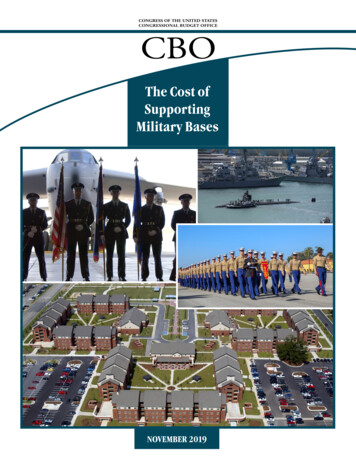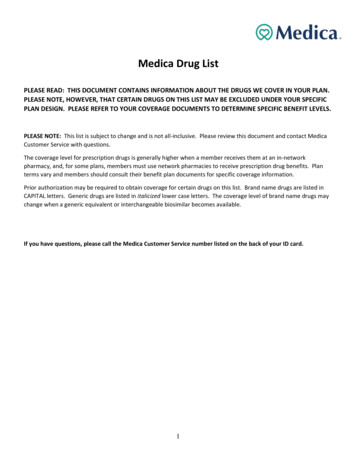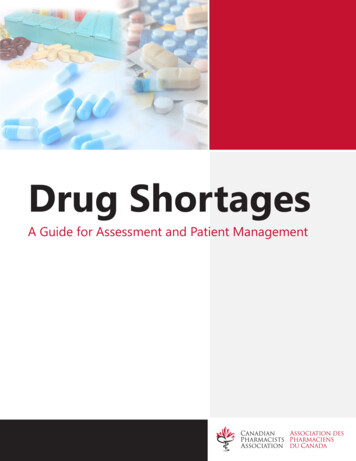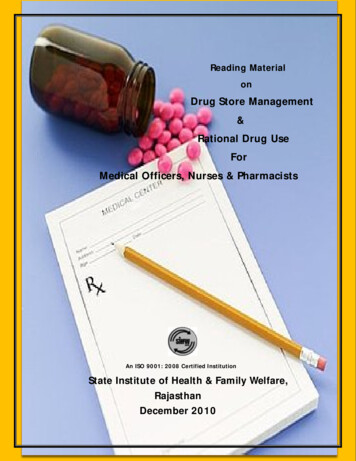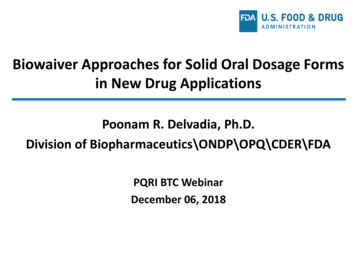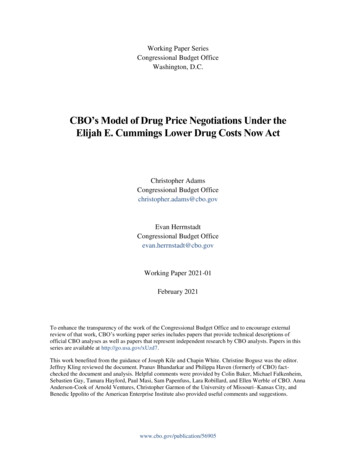
Transcription
Working Paper SeriesCongressional Budget OfficeWashington, D.C.CBO’s Model of Drug Price Negotiations Under theElijah E. Cummings Lower Drug Costs Now ActChristopher AdamsCongressional Budget Officechristopher.adams@cbo.govEvan HerrnstadtCongressional Budget Officeevan.herrnstadt@cbo.govWorking Paper 2021-01February 2021To enhance the transparency of the work of the Congressional Budget Office and to encourage externalreview of that work, CBO’s working paper series includes papers that provide technical descriptions ofofficial CBO analyses as well as papers that represent independent research by CBO analysts. Papers in thisseries are available at http://go.usa.gov/xUzd7.This work benefited from the guidance of Joseph Kile and Chapin White. Christine Bogusz was the editor.Jeffrey Kling reviewed the document. Pranav Bhandarkar and Philippa Haven (formerly of CBO) factchecked the document and analysis. Helpful comments were provided by Colin Baker, Michael Falkenheim,Sebastien Gay, Tamara Hayford, Paul Masi, Sam Papenfuss, Lara Robillard, and Ellen Werble of CBO. AnnaAnderson-Cook of Arnold Ventures, Christopher Garmon of the University of Missouri–Kansas City, andBenedic Ippolito of the American Enterprise Institute also provided useful comments and suggestions.www.cbo.gov/publication/56905
AbstractOne of the inputs that the Congressional Budget Office used to estimate the budgetary effects ofthe Elijah E. Cummings Lower Drug Costs Now Act (H.R. 3) is a simulation model of pricenegotiations. CBO modeled those negotiations using a Nash bargaining framework, which wasbased on the gains to each party—the government and the manufacturer—from a successfulnegotiation. The gain to the government was estimated to be the avoided cost of purchasing thenext-best alternative treatment, plus the incremental clinical value of using the drug of interestinstead of the alternative (measured in dollars), minus the agreed-upon price of the drug. Themanufacturer’s gain was estimated to be the revenue from selling the drug in the United States.This working paper describes the simulation model in detail, including its data sources andparameter values, and the sensitivity of the results.In CBO’s analysis, the average resulting drug price would be close to the specified upper boundof 120 percent of the index of international drug prices. Negotiations would reduce prices by 57percent to 75 percent, relative to current prices, depending on the data and parameters that wereused in the calculations. H.R. 3 specified upper and lower bounds on the prices resulting fromthe negotiations; in CBO’s estimation, changes to the upper bound would significantly affect theprices of the drugs the agency examined.Keywords: pharmaceutical prices, Nash bargaining, negotiationJEL Classification: I11, I18
ContentsIntroduction . 1Overview of Nash Bargaining . 2Modeling the Maximum Fair Price Negotiations in H.R. 3 . 4Failed Negotiations . 4Determining the Negotiated Price . 5Determining the Maximum Fair Price . 8Data Sources . 8Set of Existing Drugs CBO Analyzed . 9Current Prices of Drugs and Alternative Treatments . 10Incremental Clinical Benefits . 10International Drug Prices . 11Central Estimate and Sensitivity Analysis . 12Key Parameters of the Model and Legislative Details. 12Sensitivity of the Model to Individual Parameter Choices and Legislative Details . 15Interactions Among the Model’s Parameter Values . 16Role of the MFP Upper Bound in CBO’s Model . 16Possible Future Changes to the Model. 17Allow for Interactions Across Negotiations . 17Model the Manufacturer’s Costs . 18Incorporate a Utilization Response to Changes in Prices . 18Expand the Secretary’s Objective Function . 18Tables . 20Figures. 22Appendix: The Maximum Fair Price in a Rubinstein Alternating-Offers Model . 26
IntroductionThe Congressional Budget Office developed a model of price negotiations to estimate thebudgetary effects of the Elijah E. Cummings Lower Drug Costs Now Act.1 That legislation—also known as H.R. 3—would require that the Secretary of Health and Human Services (HHS)negotiate maximum fair prices (MFPs) for a selected set of drugs, which then would be availableat those prices to insurers participating in Medicare Part D (the prescription drug program),insurers in the commercial market, and other providers who directly administer prescriptiondrugs to individuals (such as through infusion or injection).CBO’s model, which is based on the widely used Nash bargaining framework, informed itsestimate of the effect of negotiation on pharmaceutical prices in the presence of internationalprice data. That effect fed into the remainder of the estimate. This paper describes the model, thedata and parameters used to calibrate it, and the sensitivity of the results to those decisions. Ingeneral, the results were similar using different data sources and parameter values, but thestructure of the negotiations stipulated by H.R. 3 played a major role in constraining the results.The model described below is for the introduced version of H.R. 3; the version that passed theHouse was amended in several ways, including to expand the number of drugs subject tonegotiation. CBO has not analyzed the effects of that proposal.The legislation would not allow MFPs to exceed 120 percent of the average of the prices—calledthe average international market, or AIM, price—for a given drug in six reference countries:Australia, Canada, France, Germany, Japan, and the United Kingdom. H.R. 3 would alsoestablish a target price for each drug equal to the lowest price available in any of those countries.If a manufacturer offered a price at or below the target amount during the negotiation process,that amount would become the MFP.The Secretary would choose at least 25 drugs for MFP negotiation each year beginning in 2021,and those prices would be used in Part D beginning in 2023. The set of drugs would be drawnfrom the 125 single-source drugs with the highest federal spending in Part D and with the highestnet spending (excluding any rebates provided by drug manufacturers) in the United Statesoverall. Single-source drugs have no generic or biosimilar competitors; only the company thatmade the drug holds the patent and has the exclusive right to sell the drug. The Secretary mustselect the 25 drugs that he or she projects will result in the greatest savings to the federal1For additional information, see Congressional Budget Office, letter to the Honorable Frank Pallone Jr. on theeffects of drug price negotiations stemming from Title 1 of H.R. 3, the Lower Drug Costs Now Act of 2019, onspending and revenues in Part D of Medicare (October 11, 2019), www.cbo.gov/publication/55722; and letter to theHonorable Frank Pallone Jr. regarding the budgetary effects of H.R. 3, the Elijah E. Cummings Lower Drug CostsNow Act (December 10, 2019), www.cbo.gov/publication/55936.1
government or to individuals who are eligible for the maximum fair price.2 The Secretary alsowould negotiate prices for all insulin products in the first year (2021).Pharmaceutical manufacturers that did not comply with certain requirements of title I would besubject to an excise tax on all sales of the selected drug. The amount of the tax would be apercentage of the price of each sale: It would start at 65 percent, would increase by 10 percentagepoints for each 90 days of noncompliance, and would be capped at 95 percent. Manufacturerswould be prohibited from deducting the excise tax payments from their income taxes. Thus, thecombination of income taxes and excise taxes on the sales could cause the drug manufacturer tolose money if the drug was sold in the United States. The legislation also includes civil monetarypenalties for manufacturers that sell drugs at prices higher than the maximum fair price. CBOand the staff of the Joint Committee on Taxation (JCT) expect that a manufacturer would removeits drug from the U.S. market rather than pay the excise tax.Because CBO does not know which drugs the Secretary would select for the set each year andbecause the necessary data are available only for certain existing drugs, CBO’s bargaining modelestimated the effect of negotiations on the prices for a “proxy cohort” of drugs. For thoseestimates, the agency used existing data on Medicare spending, international prices, and relativetherapeutic benefits of those drugs relative to their likely alternatives. The model applies mostdirectly to drugs that are already on the market when they are selected for negotiations and forwhich international price data are available.CBO’s full analysis of the budgetary effects of H.R. 3 used the savings implied by the bargainingmodel as only one of many inputs.3 The agency translated the output from that model intoreductions in prices for future cohorts of drugs that could be subject to negotiations and thendetermined the overall effects on the federal budget. For example, CBO’s estimate accounted forchanges in the nature of those cohorts over time relative to the proxy cohort, and it modeledmanufacturers’ ability to adjust the availability and price of the drug in foreign markets to affectthe international price data on which the negotiations are based.Overview of Nash BargainingEconomists use bargaining models to predict the outcome of a transaction when buyers andsellers both possess some degree of market power. In such cases, there is typically no singlemarket price; instead, the price is agreed upon jointly by the two parties. Because the potentialtransaction would create value for both parties, an agreement is the mutually preferred outcome.2Sec. 1192(b) of the Elijah E. Cummings Lower Drug Costs Now Act, H.R. 3, 116th Congress.3See Congressional Budget Office, letter to the Honorable Frank Pallone Jr. on the effects of drug price negotiationsstemming from Title 1 of H.R. 3, the Lower Drug Costs Now Act of 2019, on spending and revenues in Part D ofMedicare (October 11, 2019), p. 8, www.cbo.gov/publication/55722.2
However, even though neither party would want negotiations to fail, it is unclear which partywould dictate the terms of the agreement. Indeed, the point of the bargaining model is to predicthow a price would be set under such circumstances.CBO used a Nash bargaining framework in its analysis of H.R. 3. Although that framework doesnot explicitly model the strategic behavior of the two negotiating parties, it is consistent withseveral models of negotiations in which the parties do behave strategically, such as Rubinstein(1982).4 As such, the Nash bargaining framework is a standard approach to analyzingnegotiations and is used extensively in antitrust enforcement and regulatory review.5Multiple recent academic papers have specifically used a Nash bargaining framework to modelpharmaceutical price negotiations.6 Ganapati and McKibbin (2019) used it to model the prices ofgeneric and off-patent drugs across various countries outside the United States; Dubois, Gandhi,and Vasserman (2019) used it to model drug price setting in Canada and simulate how prices inthe United States and Canada would change if the United States adopted a form of referencepricing. Finally, Ladkawalla and Yin (2015) used a Nash bargaining framework to modelnegotiations among drug manufacturers, insurers, and pharmacies. In its analysis of H.R. 3, CBOapplied the Nash bargaining model to the negotiation of prices for on-patent drugs in the UnitedStates that is described in the proposed legislation.The prediction of the Nash bargaining framework, known as the Nash bargaining solution, isdetermined by two factors: the parties’ relative bargaining leverage and the parties’ relativebargaining weights. In the Nash bargaining framework (and as it is defined here), leverage isSee Ken Binmore, Ariel Rubinstein, and Asher Wolinsky, “The Nash Bargaining Solution in EconomicModelling,” RAND Journal of Economics, vol. 17, no. 2 (Summer 1986), pp. 176–188.www.jstor.org/stable/2555382; and Ariel Rubinstein, “Perfect Equilibrium in a Bargaining Model,” Econometrica,vol. 50 (1982), pp. 97–110.45The Department of Justice, Federal Communications Commission, and Federal Trade Commission have used Nashbargaining models to litigate and evaluate mergers. For example, see United States v. AT&T, Inc., 916 F.3d 1029(D.C. Cir. 2019); Jonathan B. Baker and others, “Year in Economics at the FCC, 2010–11: Protecting CompetitionOnline,” Review of Industrial Organization, vol. 39, no. 4 (December 2011), pp. 3; and Joseph Farrell and others, “Economics at the FTC: HospitalMergers, Authorized Generic Drugs, and Consumer Credit Markets,” Review of Industrial Organization, vol. 39, no.4 (December 2011), pp. 271–296, https:/doi.org/10.1007/s11151-011-9320-x. One recent analysis used a Nashbargaining model to predict whether a merger is likely to be anticompetitive and finds that the approach outperformstraditional methods; see Christopher Garmon, “The Accuracy of Hospital Merger Screening Methods,” RANDJournal of Economics, vol. 48, no. 4 (Winter 2017), pp. 1068–1102, https://doi.org/10.1111/1756-2171.12215.See Sharat Ganapati and Rebecca McKibbin, “Non-Tariff Barriers and Bargaining in Generic and Off-PatentPharmaceuticals” (draft, Georgetown University, March ract id 3313630; Pierre Dubois, Ashvin Gandhi, and ShoshanaVasserman, “Bargaining and International Reference Pricing in the Pharmaceutical Industry” (draft, HarvardUniversity, May 2019), dgv.pdf; and Darius Ladkawalla andWesley Yin, “Insurers’ Negotiating Leverage and the External Effects of Medicare Part D,” Review of Economicsand Statistics, vol. 97, no. 2 (May 2015), pp. 314–331, https://doi.org/10.1162/REST a 00463.63
determined by the net gain to a party from a successful negotiation relative to a failednegotiation, not including any payments between the two parties. If that net gain is large, thatparty will be able to obtain less favorable terms because a failed negotiation would result in alarge loss for the party. A party with less to gain from a successful negotiation (or, equivalently,with less to lose from a failed one) has more “leverage” in a colloquial sense. The bargainingweights encompass any other factors—including the party’s patience, the cost of capital, andbargaining skill—that affect the division of the total gains from an agreement.The Nash bargaining solution is the price that “splits the surplus” from a successful negotiationproportional to the parties’ relative bargaining weights. If the parties have equal bargainingweights, once the price is paid the parties will have gained the same amount, on net, from asuccessful negotiation relative to a failed negotiation.The Nash bargaining framework can incorporate constraints on the possible outcomes of thenegotiations, an aspect that is particularly relevant to CBO’s analysis of H.R. 3. Although theconstraints do not directly affect CBO’s analysis of the bargaining leverage or the bargainingweights, they ensure that the outcome is restricted to a certain range. If the negotiations wouldotherwise fall outside that range, the constraints may effectively “pull” the resulting outcomeback to the boundary of the acceptable range of outcomes.Modeling the Maximum Fair Price Negotiations in H.R. 3There are two steps to the model that CBO used to estimate the MFPs that would result fromnegotiating the net prices of selected drugs under H.R. 3. In the first step, CBO computes thenegotiated price, which is determined on the basis of the gains from a successful negotiationrelative to a failed negotiation and the relative bargaining weights of the two parties. In thesecond step, CBO determines the MFP by comparing the negotiated price to bounds defined inthe legislation. Specifically, the MFP is equal to the negotiated price if it falls between the upperand lower bounds. If the negotiated price exceeds the upper bound, the MFP is equal to the upperbound. If the negotiated price is less than the lower bound, the MFP is equal to the lower bound.Failed NegotiationsThe consequences of a failed negotiation are an important determinant of the MFP. If drugmanufacturers faced no meaningful consequences from a failed negotiation, the Secretary wouldhave very little bargaining leverage.7 Under H.R. 3, manufacturers that do not agree toparticipate in negotiations or that fail to agree to a negotiated price would be subject to an excisetax on the drug’s sales, in addition to income taxes. CBO and JCT expect that a manufacturerwould take its drug off the U.S. market rather than pay the excise tax, so that tax would have the7See Congressional Budget Office, letter to the Honorable Chuck Grassley concerning negotiation over drug pricesin Medicare (May 17, 2019), www.cbo.gov/publication/55270.4
same effect as if the drug had not been approved for sale or as if the drug was excluded from anational list of drugs (that is, a formulary) that any insurer could cover. The potential use of theexcise tax and anticipated removal of the drug from the United States would serve as a source ofpressure on both parties to reach an agreement.In a onetime interaction, both the Secretary and the manufacturer would prefer any agreement toa failed negotiation. So how can the excise tax act affect the negotiation? It can be understood intwo ways. First, such questions of strategic decisionmaking can be understood through theRubinstein model, in which the parties alternate offers until one is accepted; if they persistentlyreject one another’s offers, the negotiation fails.8 However, that never happens in the equilibriumof the model; instead, the parties immediately agree on the Nash bargaining solution. So eventhough the parties always come to an agreement, the spectre of protracted disagreement andfailure disciplines the outcome.Second, one can appeal to the intuition of a repeated negotiation in which the manufacturer andSecretary will negotiate over many drugs over time.9 The manufacturer would not want to reveala willingness to accept a very low price regardless of the benefit conferred by the drug, lest itencourage similarly low offers in the future; thus, the threat of disagreement remains an option asa response to an unreasonably low offer. Conversely, the Secretary would not want to reveal awillingness to pay a very high price regardless of the benefit conferred by the drug; thus, thethreat of disagreement remains an option as a response to an unreasonably high offer.Determining the Negotiated PriceIn the absence of bounds on the MFP, the negotiated price is the solution to the bargaining modelthat CBO used to estimate H.R. 3. Formally, that solution is the price that maximizes theweighted product of the two parties’ gains from coming to an agreement.In the model, the manufacturer’s benefit from an agreement is equal to its revenue from sellingthe drug, which is calculated as the negotiated price multiplied by the quantity sold. Themanufacturer’s benefit from a failed negotiation is zero because the manufacturer is expected toremove the drug from the U.S. market in that case. Therefore, the net gain to the manufacturerfrom a successful negotiation is equal to the negotiated price multiplied by the quantity sold inthe U.S. market.In addition, the Secretary’s per-beneficiary, per-year benefit from an agreement is equal to theaverage per-beneficiary, per-year value of the drug to a beneficiary taking the drug, minus the8See the Appendix for a full characterization of the Rubinstein model in the context of MFP negotiations.9Although CBO does not explicitly model each MFP negotiation as part of a series of bargains, such a frameworkprovides another intuitive reason that the excise tax could encourage an agreement.5
negotiated price.10 That value is the clinical benefit of the drug (as measured in dollars), and it ismultiplied by the quantity sold to Medicare beneficiaries. The benefit from a failed negotiation isthe clinical benefit of the next-best alternative treatment (which might be a different drug or evena nonpharmaceutical treatment) minus the price of that treatment. Therefore, the gain to theSecretary from a successful negotiation is the incremental clinical benefit of the drug minus theincremental price of the drug, relative to the alternative treatment.11The model reflects two technical assumptions about the payoffs to the parties. First, the cost ofproducing, distributing, and marketing the drug in the United States is assumed to be zero.Although that may be a reasonable approximation for some drugs, it overstates the gain to themanufacturer from an agreement. Incorporating nonzero costs to manufacturers would result inhigher negotiated prices. Second, use of the drug does not change with the negotiated price (orneither party accounts for such a change while negotiating). To the extent that there is a changein use and it is a factor in the negotiations, a lower price generates more surplus, which creates amutual incentive to settle on a lower price than the parties otherwise would. In CBO’ssimulation, the negotiated prices for most drugs are predicted to lie above 120 percent of theAIM price, so small deviations from these assumptions would probably have little effect on theoverall estimate of reduced federal spending.The Nash bargaining problem is expressed mathematically as:max [𝑞𝑚 (𝑒 𝑝) 𝑞𝑚 (𝑒𝑎 𝑝𝑎 )]𝜆 [(𝑞𝑚 𝑞𝑜 )𝑝 0]1 𝜆𝑝The gain for each party is its payoff from a completed negotiation minus its payoff from a failednegotiation. The first term in brackets is the Secretary’s gain from a completed negotiationrelative to a failed negotiation: The health benefit to a Medicare beneficiary from receiving that drug (𝑒), minus the amountof money paid for the drug under the potential negotiated price (𝑝), times the number ofMedicare beneficiaries receiving treatment (𝑞𝑚 ), minus10The model does not account for possible spillover benefits to other beneficiaries, such as benefits associated withvaccines.11When CBO estimates the budgetary effects of a policy that changes the number of prescriptions filled, the agencytypically applies a “medical offset” that captures associated changes in other medical expenditures. The bargainingmodel does not account for that medical offset to the drug being negotiated or the relevant alternative treatments.Instead, CBO applies the medical offset to the changes in future drug spending as computed in the main budgetaryanalysis, to which the bargaining model is one input. For more details about the medical offset, see CongressionalBudget Office, Offsetting Effects of Prescription Drug Use on Medicare’s Spending for Medical Services(November 2012), www.cbo.gov/publication/43741.6
The health benefit to a Medicare beneficiary from receiving the alternative treatment (𝑒𝑎 ),minus the amount of money paid for the alternative treatment (𝑝𝑎 ), times the number ofMedicare beneficiaries receiving treatment (𝑞𝑚 ).The second term in brackets is the manufacturer’s gain from a successful negotiation relative to afailed negotiation: The revenue from selling the drug to the entire U.S. market, minus the number of Medicarebeneficiaries using the drug (𝑞𝑚 ), plus the number of other fair-price-eligible individualstaking the drug (𝑞𝑜 ), times the potential negotiated price (𝑝), minus Zero U.S. revenue from the drug it is taken off the market.The exponents 𝜆 and (1 𝜆) represent the relative bargaining weights of the Secretary andmanufacturer, respectively. In this context, those bargaining weights succinctly capture a numberof factors, including the Secretary’s preference to hold out for low prices, potential politicalramifications for the Secretary if negotiations are delayed, the public relations consequences forthe manufacturer if it is perceived as being unwilling to negotiate, and the relative costs ofcapital between the parties.The negotiated price solves the Nash bargaining model above and is equal to(1 𝜆)(𝑒 𝑒𝑎 𝑝𝑎 ). That is, the parties split the incremental clinical benefit of the drug plusthe avoided price of purchasing the alternative treatment. The negotiated price has a sensiblerelationship to the opportunity cost of the drug from the Secretary’s perspective. If the drugprovides a large therapeutic benefit over the existing alternative, the negotiated price would tendto be high. If the drug is used in place of an expensive alternative treatment, the negotiated pricewould also tend to be high. Those are both cases in which the Secretary would receive largegains from access to the drug, so his or her leverage would be low. The bargaining weight 𝜆determines how the negotiated price would divide the net benefit of the drug between the twoparties. If the bargaining weights are 50-50 (that is, if 𝜆 0.5), the split would be even. TheSecretary would receive the net benefit of the drug but pay half of it to the manufacturer throughthe negotiated price.12Because current prices are negotiated between manufacturers and insurers, CBO’s model assumes a ceiling onprices that could be negotiated between the Secretary and manufacturers. In the model, the negotiated price isconstrained to a range below the current price and above zero. That parameter makes little difference in CBO’sanalysis of H.R. 3 because the MFP is typically constrained by the target price or 120 percent of the AIM price. Inthe context of modeling future policies that did not include an AIM-based upper bound or similar constraint,however, that modeling assumption could be more consequential.127
In CBO’s model, the cost of the alternative treatment reflects its current-law price. That pricecould also be negotiated under the legislation, however, so the two negotiations could interactwith one another because one drug’s MFP would feed into the negotiation over the other drug’sMFP. In CBO’s full analysis of the budgetary effects of H.R. 3, the agency adjusted its estimateto account for some competitive pressure among drug prices elsewhere in the analysis rather thanexplicitly characterize it in the bargaining model. Nonetheless, the results are similar using a“Nash-in-Nash” (Nash-equilibrium-in-Nash-bargaining) framework in which the price of analternative treatment is that treatment’s model-predicted MFP if it is negotiated.13Determining the Maximum Fair PriceH.R. 3 effectively constrains the MFP to lie between the target price and 120 percent of the AIMprice. That constraint does not directly affect the negotiated price, but it can prevent the partiesfrom agreeing to an MFP equal to the negotiated price.14 If the negotiated price was below thetarget price, the manufacturer would offer the target price and the Secretary would have toaccept. That outcome could occur if a drug has a small incremental clinical benefit, aninexpensive alternative, or an especially high target price. Conversely, if the negotiated priceexceeded 120 percent of the AIM price, the parties would agree to an MFP equal to 120 percentof the AIM price. That outcome could occur if the drug has a large incremental clinical benefit,an expensive alternative, or an especially low AIM price. Finally, if the negotiated price liesbetween the target price and 120 percent of the AIM price, the MFP would equal the negotiatedprice.15 For a graphical summary of the three cases as applied to a hypothetical drug with a targetprice of 800 and an AIM price of 1,000, see Figure 1. In that figure, the target price and 120percent of the AIM price are shown using dotted lines. Between those lines, the MFP is equal tothe negotiated price. Outside those lines, the MFP is equal to one of the bounds.Data SourcesTo model the effect of negotiation on the prices of future cohorts of drugs, CBO analyzed a setof existing drugs for which the necessary data were availab
2 Sec. 1192(b) of the Elijah E. Cummings Lower Drug Costs Now Act, H.R. 3, 116th Congress. 3See Congressional Budget Office, letter to the Honorable Frank Pallone Jr. on the effects of drug price negotiations stemming from Title 1 of H.R. 3, the Lower Drug Costs Now Act of 2019, on spending and revenues in Part D of

